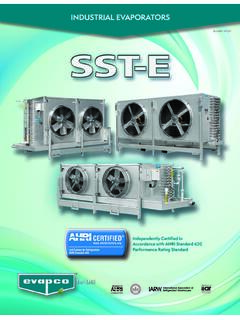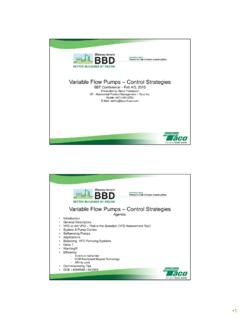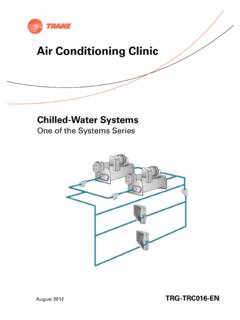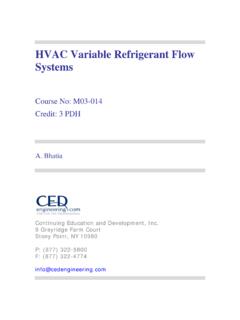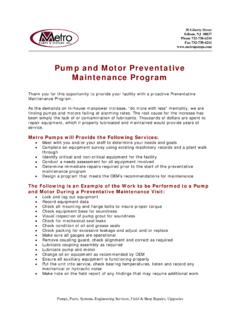Transcription of ENGINEERING BULLETIN . EB23D Product: Cooling Towers ...
1 ENGINEERING BULLETIN 23D April 16, 2010 Page 1 of 28 ENGINEERING BULLETIN No. EB23D Product: Cooling Towers Free Cooling Operation Date: April 16, 2010 Table of Contents Section Page I. Introduction/ Background 2 II. System design Considerations: Cooling Tower Selection 5 Unit Layout 6 Cooling Tower Piping 7 Cooling Tower Accessories
2 8 III. Capacity Control Methods 10 Induced Draft Unit Operation 11 Forced Draft Unit Operation 12 Multiple Cell Unit
3 Operation 13 IV. Ice Management Induced Draft Units 16 Forced Draft Units 17 V. Unit Maintenance 17 Conclusions 18 Appendices: A: Maintenance Checklist 19 Induced Draft Towers : B: Two Speed Fan Motor Control Sequences 21 C: Variable Speed Fan Motor Control Sequence 22 Forced Draft Towers : D.
4 Two Speed Fan Motor Control Sequences 23 E: Variable Speed Fan Motor Control Sequence 24 F: System design Guidelines 25 G: System Operation Troubleshooting Guidelines 27 ConfidentialEngineering BULLETIN 23D April 16, 2010 Page 2 of 28 I. Introduction: Cooling Towers are used to dissipate heat from air conditioning or industrial process systems. Many of the air conditioning systems currently in use only operate during the summer Cooling season, but there are numerous air conditioning and process systems that require Cooling year-round.
5 In some cases, the entire Cooling system is required to operate during the winter. The Cooling tower is required to provide the same 85 F or colder water to the system as it does in the summer, but it does so at lower ambient temperatures. However, there are some applications designed to use the Cooling tower for free Cooling . Free Cooling is when chilled water is cooled by Cooling tower water through the use of heat exchangers without the use of refrigerant compressors. Free Cooling can be accomplished when ambient conditions allow the Cooling tower to produce chilled water for the system.
6 When the tower is providing chilled water to the system, there are periods of time when it must operate in subfreezing conditions. During these periods, when the tower is subjected to very cold ambient conditions, there is greater potential to produce ice in the Cooling tower or elsewhere in the system. If an inappropriate Cooling tower design is chosen, or if the unit is not operated or winterized properly, excessive amounts of ice can form in the unit resulting in decreased capacity, operational difficulties, and potential damage to the tower.
7 Cooling tower performance in free Cooling applications is dependent upon both the system and Cooling tower design . The control sequences applied to the Cooling system must consider management of both the air and water side of the Cooling tower. It is essential that the proper control sequences be applied during free Cooling to ensure adequate operation of the Cooling tower during low ambient conditions. When a requirement for free Cooling is specified for a project utilizing Cooling Towers , certain considerations must be made from the very beginning of the project design .
8 First, special care must be taken when laying out the Cooling Towers to prevent recirculation due to poor tower location and prevailing winds. If a strong prevailing wind is present, adding wind walls to an induced draft tower should be considered. Second, the Cooling tower should be equipped with basic options such as basin heaters, electric water level control, and vibration switches to prevent operational issues due to basin freezing if a remote sump is not possible. Lastly, capacity control must also be carefully considered, especially if the winter Cooling load is significantly less than the summer load.
9 Shutting down individual cells of a multiple cell Cooling tower or employing a low-flow header on a singe cell should be utilized. A minimum leaving water temperature of 45 F must be maintained at all times. Evapco s counterflow Cooling Towers are well suited for free Cooling operation. In a counterflow Cooling tower, the fill is completely enclosed and protected from ENGINEERING BULLETIN 23D April 16, 2010 Page 3 of 28 outside elements, such as wind, that can cause freezing of the fill pack in low ambient conditions.
10 Additionally, the fill pack is supported from below to prevent sagging in the event freezing should occur due to a system imbalance. The fans, fan motors, and drive systems of Evapco counterflow Cooling Towers are also designed to be safely run in reverse at up to 50% normal fan speed. However, there are several items to consider when operating a counterflow Cooling tower in a free Cooling mode. This ENGINEERING BULLETIN will examine the following items in detail: Cooling tower design considerations, capacity control and ice management methods for both forced and induced draft units, and proper maintenance procedures to ensure successful operation of the Cooling tower during free Cooling .

